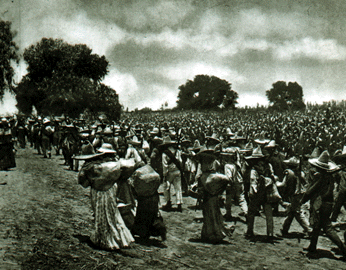 |
Peoples' movements and protests |
 |
|
MobilizationsThe Grundtvigian peasant movementIrish Land LeagueBavarian Farmers’ UnionFarmer’s AllianceThe Zapatists of MorelosKisan SabhaThe Chinese peasant movementThe Vietnamese peasant movementLa ConvenciónKRRS and Shetkari SanghatanaFrench peasant resistanceThe Zapatists of Chiapas Via Campesina
|
The Zapatists of Morelos
Mexico around 1900 was ruled by a group of politicians and entrepreneurs who sought to adapt the country to the world market. Among other things, they strove for the farmers’ land to be taken over by plantations for world market production. In the small state of Morelos south of Mexico DF, there were sugar plantations that, with the support of courts and politicians, increasingly occupied the land of the villages. In 1910, Mexico’s dictator was to be re-elected, but a fly of the bourgeoisie in the north reacted against the rule of the minority, revolted and demanded democracy. This was exploited by the farmers of three villages in Morelos – Anenecuilco, Moyotepec and Villa de Ayala – who invaded the land that the sugar plantations had stolen and planted maize. Thanks to the uprising in the north, the authorities did not have time to stop them and their initiatives spread to several villages, and soon enough they also joined the uprising against the dictator. This uprising was successful. The dictator fled and the rebel leader became president – and sent the military to defeat Morelo’s peasants so that government power would not be threatened. But despite a genocidal policy that cost a quarter of Morelo’s residents their lives, the military never succeeded in defeating the peasants. For ten years, they were able to take advantage of a mobile warfare that eventually bound the military to a few fortified sites, while carrying out their own land reform that driving away the sugar plantations. In 1921, they concluded an agreement with a reformist fly from the north and helped it conquer state power. As a reward, they had their land reform recognized and enshrined in the constitution. Unfortunately, the peasant movement was limited to Morelos and its immediate surroundings. Therefore, the land reform had limited impact. In the rest of Mexico, it was implemented only in part, as a gift from a benevolent paternalistic state in the 1930s, with the idea that the peasants would thankfully support the government in elections and charge low prices for food. Morelo’s farmers’ lasting achievement was to establish land reform on the global agenda as an inevitable part of a modernizing policy. Land reforms were also carried out in almost the whole world, for the benefit of hundreds of millions of farmers – though not for the majority.
Reading
|

